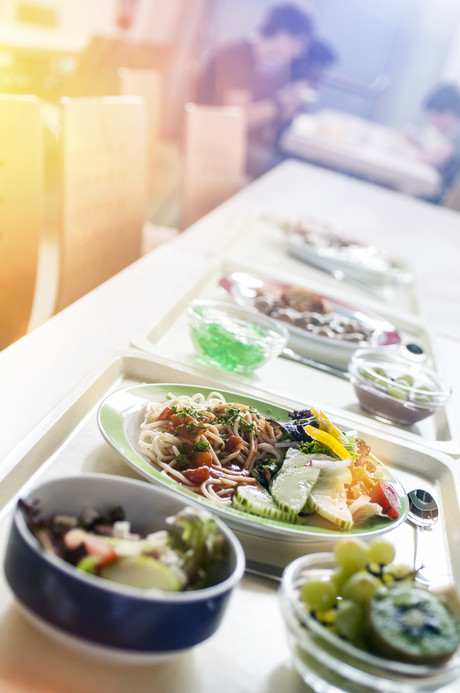Coming to grips with food waste

Waste is highly prevalent throughout the health system, and hospital foodservices represent one of the greatest sources of hospital waste. One study estimates it contributes 50% of all waste produced1.
Waste is financially burdensome and also represents wasted utilities and labour. A recent Portuguese study estimated 0.5% of their National Healthcare Budget gets thrown away in food waste2.
Food waste also has grave implications for the planet — decomposing food in landfill generates methane gas, which is 25 times more potent than carbon dioxide at trapping heat3. Hospital foodservices will produce some food waste due to the demographic they service: patients, whose poor health status can impact their intake and ultimately results in unavoidable waste. But there is also avoidable food waste from overproduction, poor purchasing and poor storage practices. Another obvious, but often neglected source of avoidable waste is unserved plate waste. This occurs when food is plated for a patient but the tray doesn’t actually make it into the patient’s room. The changing dietary requirements of patients, transfers and early discharges can all contribute to this waste.
Recycle Food Project
Student projects on food waste at The Royal Children’s Hospital (RCH) Melbourne estimate the hospital is throwing away in excess of $127,000/year or $1.74 per person per day on food. This includes 318 portion controlled (PC) food items per day (30% of all PC food items served) that are returned to the kitchen completely untouched and then thrown out. Half of these packaged foods are shelf stable (do not require refrigeration).
The concept of re-use in a hospital setting remains elusive, for reasons of food safety (both microbial and allergen management), quality control, nutritional consistency and infection control. Anything that has gone into a patient room is considered ‘contaminated’, and in some cases, with good reason.
With all of this in mind, the RCH undertook work to reduce food waste and cost by introducing the Recycle Food Project. With measures in place to minimise contamination, unserved shelf-stable foods and cutlery are recycled back into the kitchen and used first at subsequent meal times. This saves labour and food costs, and importantly, opens new avenues for waste prevention discussions.
A foodservice supervisor with good leadership qualities and a good understanding of kitchen operations instigated this project. While this is great for staff engagement, there were still a number of challenges, including staff concerns around food safety and infection control, as well as extra workload. To overcome these concerns, focus was placed on the environmental and moral benefits. Extensive negotiation with staff ensured a fair distribution of the work and assignment of responsibilities.
This project shows how a comprehensive picture of hospital food waste can be used to target areas of high volume, high cost and avoidable food waste.
Accredited Practicing Dietitians (APDs) are university-qualified in foodservice management and can lead projects in foodservice waste. Contact your dietetics department or locate foodservice consultant APDs via ‘Find an Accredited Practising Dietitian’ at www.daa.asn.au.
1. Goonan S, Mirosa M & Spence H 2014, ‘Getting a Taste for Food Waste: A Mixed Methods Ethnographic Study into Hospital Food Waste before Patient Consumption Conducted at Three New Zealand Foodservice Facilities’, Journal Of The Academy Of Nutrition And Dietetics, Vol. 14, No. 1 pp. 63-70.
2. Dias-Ferreira, C, Santos, T & Oliveira, V 2015, ‘Hospital Food Waste and Environmental and Economic Indicators – A Portuguese Case Study’, Waste Management, Vol. 46, pp. 146-154.
3. Food and Agriculture Organization of the United Nations 2011, Sustainable Pathways, Food Wastage Footprints, FAO, Viewed 7 September 2017, www.fao.org/nr/sustainability/food-loss-and-waste.
**************************************************
Kathy has put together a scoping survey to better understand how much foodservice waste we are generating (in Australia) and how we are managing it. Its purpose is to seek out what others are doing to reduce – reuse – repurpose – recycle waste. If you’re keen to contribute to a better understanding of foodservice waste quantities and management, complete this short survey www.surveymonkey.com/r/Z3QZYF5.
**************************************************

Should chatbot psychologists be part of the health system?
This year, an announcement that chatbot psychologists could become part of Australia's...
New guidelines for concussion and brain health released
The Australian Institute of Sport, in close collaboration with the Australian Physiotherapy...
Shifting the dial on obesity
In 2018, 8.4% of the total burden of disease in Australia was due to overweight and obesity,...










